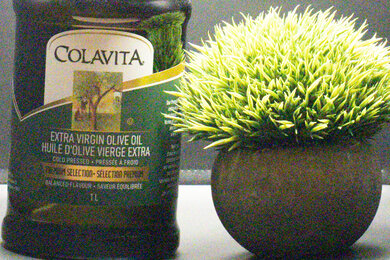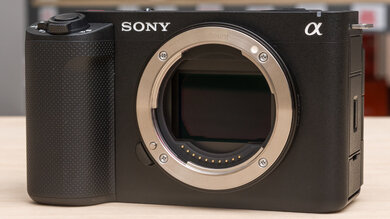
Generally speaking, the bigger the sensor, the better for low-light photography. While you can't go wrong with a full-frame camera in low light, your mileage will vary greatly depending on the lens you use, and you can still get great results in low light with a crop sensor camera, given the right lens. An APS-C or even Micro Four Thirds camera also offers advantages like portability and smaller lenses, so it's all about weighing your needs. Thankfully, modern digital camera sensors have become increasingly efficient at gathering light, allowing for ever-higher ISO settings and usable images with minimal noise in very dim lighting.
Of course, when shooting in dimmer conditions, you can minimize the appearance of noise by allowing more light to hit the sensor, either by increasing your exposure time or opening up your aperture. When shooting handheld, built-in image stabilization might be necessary, allowing you to get clear shots at slower shutter speeds. Above all, the lens you use will have the biggest impact. A lens with a wider maximum aperture can let in more light and let you shoot in darker conditions at faster shutter speeds.
We've bought over 100 cameras, and below, you'll find the best low-light mirrorless cameras we've tested. You can also learn more about how we test for image noise here. If you're looking for more general-purpose recommendations, check out our list of the best cameras for photography. If, on the other hand, you're looking for a hybrid or video-centric camera for low-light shooting, you can also see our top videography and filmmaking cameras. Or, maybe you're just looking for the best cameras we've tested, period. In any case, you're sure to find something to suit your needs.
-
Best Camera For Low Light
Travel Photography7.9Landscape Photography8.2Sport & Wildlife Photography8.3Raw Photo Performance8.6Vlogging7.8Studio Video9.2Action Video5.8Body TypeSLR-StyleMirrorlessYesSensor SizeFull FramePhoto RAW Noise8.0The Canon EOS R6 Mark II is the best camera for low light that we've tested. It offers notable improvements over the Canon EOS R6, including a higher-resolution sensor, an updated autofocus system, and improved video features like uncropped 4k video at up to 60 fps. Despite the higher resolution, the R6 Mark II still performs incredibly well in low light, with amazing noise handling in low light. The added resolution also gives you a touch more flexibility to crop your photos compared to its predecessor.
That aside, it has an incredibly effective autofocus system, with subject tracking that works well even in low light. The camera's five-axis in-body image stabilization (IBIS) system can also help you shoot handheld at slower shutter speeds. That said, lens selection is still relatively limited for Canon's RF-mount. If you want more third-party lens options, the Sony α7 IV is another top contender with a wider selection of lenses, although its ergonomics aren't quite as good. The original R6 is also still an excellent choice despite its lower-resolution sensor and slightly worse video specs.
-
Best Camera For Low Light Video
Travel Photography8.7Landscape Photography8.7Sport & Wildlife Photography8.6Raw Photo Performance8.6Vlogging7.9Studio Video8.4Action Video8.0Body TypeSLR-StyleMirrorlessYesSensor SizeFull FramePhoto RAW Noise8.6The Sony ZV-E1 isn't just the most advanced vlogging camera on the market—it's also a fantastic choice for low-light videography. Using the same low-light-optimized sensor as the high-end Sony α7S III and Sony FX3 but sitting at a much more accessible price point, the ZV-E1 can record incredibly high-quality video, even in the trickiest lighting conditions. It's also remarkably compact for a full-frame camera and includes in-body image stabilization, so it's a good fit for run-and-gun style videography.
The Panasonic LUMIX GH5s is another great option for low-light video, with a low-resolution, dual-native ISO sensor optimized for low light. However, it's a smaller sensor than the ZV-E1, but opting for the Micro Four Thirds system means more compact lens options and a more effective IBIS system. It's also less prone to overheating. Just be aware that its autofocus pales compared to Sony's real-time phase detection AF. Still, the GH5s will save you money if you prefer to focus manually. Otherwise, the ZV-E1 sensor is hard to pass up for low-light shooting.
-
Best Upper Mid-Range Camera For Low Light
Travel Photography8.0Landscape Photography8.7Sport & Wildlife Photography7.7Raw Photo Performance8.9Vlogging7.7Studio Video9.4Action Video5.6Body TypeSLR-StyleMirrorlessYesSensor SizeFull FramePhoto RAW Noise8.1If the cameras above are a little out of your price range, check out the Panasonic LUMIX S5 II. This full-frame model has top-tier noise handling performance, so you'll get exceptionally clean image files even in poor lighting. The original Panasonic LUMIX S5 is a steal of a camera, and the S5 II improves on it in some key ways, most notably with a new phase-detection autofocus system. While it's still no match for Canon's Dual Pixel AF system, it does perform fairly well overall.
On top of that, this camera is a video powerhouse, with advanced features like internal 10-bit recording, 4k at up to 60 fps, and a wide range of recording formats and codecs. L-mount lenses aren't the cheapest, but with compatible options available not just from Panasonic but also from Leica and Sigma, you'll have a wide range to choose from. If you're more strictly interested in photography, the Nikon Z 6II is another great option at this price point. It lacks the S5 II's more advanced video features, but it's a great low-light performer for photography, with excellent ergonomics and an even more reliable autofocus system.
-
Best Mid-Range Camera For Low Light
Travel Photography8.3Landscape Photography8.2Sport & Wildlife Photography8.3Raw Photo Performance7.9Vlogging7.8Studio Video8.3Action Video7.6The Sony α6700 is the best mid-range camera we've tested. Sony cameras are some excellent low-light mirrorless cameras, and the α6700 is no exception. Though it uses an APS-C sensor, this hybrid model is very well-rounded, with one of the most sophisticated autofocus systems on the market, in-body image stabilization, and 4k video recording at up to 120 fps. Beyond that, you'll find plenty of amazing native and third-party lenses for this camera, with some offering excellent value, like Sigma's trio of f/1.4 prime lenses that are all well-suited for low-light shooting.
Another great option in this price range is the Fujifilm X-S20, which goes toe to toe with the α6700 in many ways. Like the Sony, it has IBIS, a high-res APS-C sensor, and high-end video specs. Fujifilm also offers some of the fastest APS-C prime lenses on the market, like the XF 50mm f/1.0 R WR. That said, its AF system isn't as reliable as the Sony. Photographers who want to save money can also consider the older Fujifilm X-S10, which uses the same sensor as the X-S20 and offers a lot of value for its price but falls short in video features compared to the X-S20, with no internal 10-bit or 6.2k recording.
-
Best Entry-Level Camera For Low Light
Travel Photography7.5Landscape Photography8.1Sport & Wildlife Photography7.3Raw Photo Performance8.4Vlogging6.1Studio Video8.0Action Video4.1Body TypeSLR-StyleMirrorlessYesSensor SizeFull FramePhoto RAW Noise8.0The Nikon Z 5 isn't the camera to get if you're interested in shooting video, with severely cropped 4k recording and a slow burst rate relative to higher-end models. However, you won't find a better full-frame camera body at this price point, making it the best camera for night photography for entry-level shooters. It has an excellent full-frame sensor that captures fantastic overall image quality, superb ergonomics, a high-res EVF, and even includes some premium features like dual SD card slots and in-body image stabilization.
Nikon's Z series has some fantastic lens options, particularly within the premium S Line. Though third-party options are still limited compared to competitors like Sony, the Z system continues to grow. Ultimately, if you need full-frame image quality and low-light performance and you're primarily interested in photography, the Z 5 will get you there without costing a fortune.
-
Best Budget Camera For Low Light
Travel Photography7.9Landscape Photography7.5Sport & Wildlife Photography8.0Raw Photo Performance7.4Vlogging8.0Studio Video8.1Action Video4.9The Canon EOS R50 is a great choice for low-light shooting on a budget. It's an especially good choice for people jumping from a smartphone to their first "real" camera, as it's a solid beginner model with an intuitive user interface, simple controls, and plenty of creative shooting modes for those who don't know their way around settings just yet. Its portable size also makes it easy to take traveling or on the go.
Despite its small size, the R50 packs a punch with an excellent sensor that performs well for its class, even in trickier lighting. While its autofocus system isn't as advanced as the Canon EOS R6 Mark II mentioned above, it's still fairly effective, and the camera has surprisingly advanced video specs for the price. Its biggest drawback is the relatively limited selection of lenses for Canon's RF mount. The Olympus OM-D E-M10 Mark IV is a great alternative with a more established lens ecosystem. It even has IBIS, which is rare at this price point. However, its autofocus is much less reliable.
Notable Mentions
- Nikon D780: The Nikon D780 is a fantastic DSLR camera for low-light photography. It's bulkier than a mirrorless option like the Canon EOS R6 Mark II, and it lacks IBIS, but its full-frame sensor has some of the best low-light noise handling we've tested. See our review
- PENTAX K-3 Mark III: The PENTAX K-3 Mark III is a premium APS-C DSLR camera with high ISO performance that practically rivals some full-frame cameras. However, it's expensive, and its autofocus system isn't as reliable as mirrorless cameras like the Sony α6700 or the Canon EOS R6 Mark II. See our review
- Sony α6600: The Sony α6600 is the predecessor to the Sony α6700 and a good option if you want to save some money. Like its successor, it has IBIS. However, it uses an older autofocus system and lags behind in video features. See our review
Recent Updates
-
May 27, 2024: We removed the Fujifilm X-T4 from the Notable Mentions as it's less relevant for low-light shooting in the current market.
-
Mar 29, 2024: We've updated some of the article photos and featured test results so they're more relevant to low-light usages. We also reviewed the picks, their prices, and their availability to ensure they're still the best choices for users.
-
Feb 02, 2024: Moved the Nikon D780 to the Notable Mentions to simplify the scope of recommendations.
-
Dec 07, 2023: Replaced the Nikon Z 6II with the Panasonic LUMIX S5 II as the upper mid-range pick since it's more well-rounded for video; replaced the Fujifilm X-S10 with the Sony α6700 as the mid-range pick because of its wide range of lens options; added the Nikon Z 5 as an entry-level option, because of its incredible value for its price.
-
Oct 11, 2023: Replaced the Olympus OM-D E-M10 Mark IV with the Canon EOS R50 as the budget pick because of its cheaper price and larger sensor.
All Reviews
Our recommendations above are what we think are currently the best cameras for most people to buy for low light situations, according to their needs. We factor in the price, feedback from our visitors, and availability (no cameras that are difficult to find or almost out of stock in the U.S.).
If you'd like to choose for yourself, here's the list of all of our camera reviews arranged according to the criteria required for low-light photography. Be careful not to get caught up in the details. There is no single perfect camera. Personal taste, preference, and shooting habits will matter more in your selection.





























